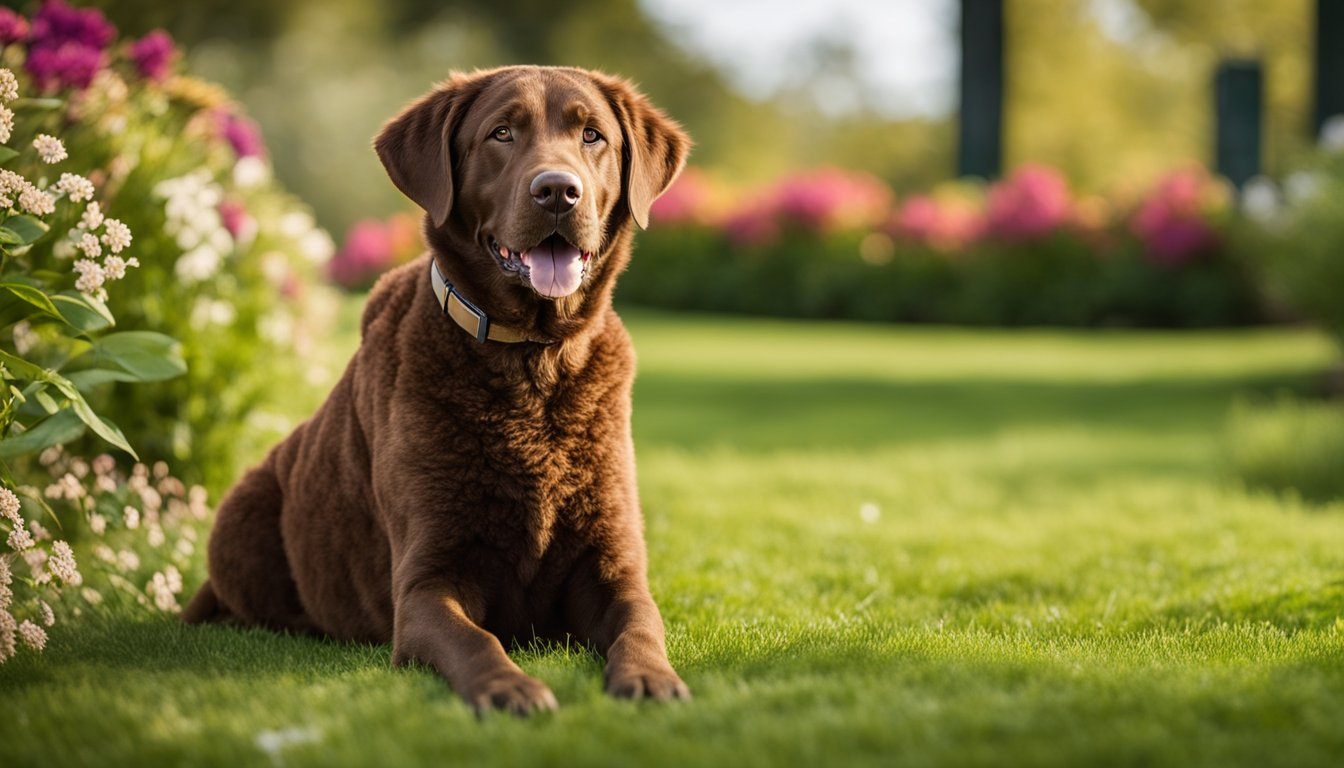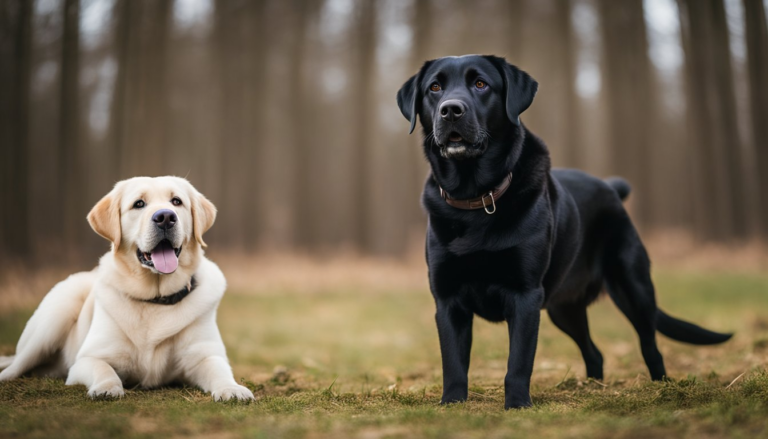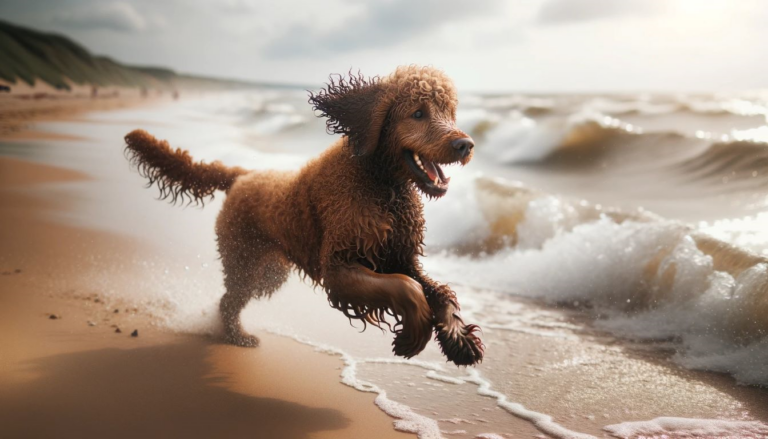Chesapeake Bay Retriever Breed Guide: History, Facts, and Tips
The Chesapeake Bay Retriever, affectionately known as the “Chessie,” is an intelligent and versatile breed originally developed in the United States for waterfowl hunting. Renowned for their loyalty and protective instincts, these dogs have a strong connection with their owners and the game they retrieve.
Their unique physical characteristics, including a dense, waterproof coat and webbed feet, enable them to excel in both water and land activities, making them a popular choice among hunters and active pet owners alike.
Despite their hunting background, Chesapeake Bay Retrievers are also known for their friendly and affectionate demeanor, making them excellent family dogs. It’s important for their owners to be attentive to their health and wellness needs, as well as their living conditions to keep them happy and thriving.
Training and socialization are vital, as the breed’s protective nature can sometimes make them cautious around strangers and other dogs. By understanding the characteristics and needs of the Chessie, you’ll be well-equipped to provide the best care and companionship for your four-legged friend.
Key Takeaways
- Chesapeake Bay Retrievers are loyal, intelligent dogs originally bred for waterfowl hunting, with unique physical features for water activities
- They possess friendly and affectionate temperaments, making them great family dogs, but require proper training to manage their protective instincts
- Owners should pay attention to health, grooming, and living conditions to keep their Chessie satisfied and comfortable
Breed History and Origin
Development and Origins
The Chesapeake Bay Retriever traces its roots back to the early 19th century when two Newfoundland dogs were rescued from a shipwreck off the coast of Maryland. These dogs, a male named Sailor and a female named Canton, were bred with local retrievers, shaping the foundation of the Chesapeake Bay Retriever breed, one of the many types of retrievers. They were initially called “Chesapeake Bay Ducking Dogs,” reflecting their primary role as waterfowl retrievers for hunters in the region of Chesapeake Bay.
Over time, breeders began to prioritize qualities such as loyalty, protection, and the ability to retrieve game in icy waters, resulting in a breed with a unique combination of traits. The breed was officially recognized by the American Kennel Club (AKC) in 1878 and remains a popular choice for waterfowl hunters in Maryland, Virginia, and other nearby regions.
Original Purpose
The primary purpose of the Chesapeake Bay Retriever was to serve as a skilled waterfowl-retrieving dog, capable of handling the challenging conditions of the Chesapeake Bay region. Waterfowl hunters valued the breed for its endurance, strength, and ability to swim in icy waters while retrieving ducks or other game.
The Chesapeake Bay Retriever’s coat is particularly well-suited for this task, as it is dense, water-resistant, and insulating, providing protection in the cold and wet environments that the breed was initially developed for. The breed’s history as a hunting companion has led to its strong loyalty and protective nature, making Chesapeake Bay Retrievers a reliable choice for hunters and families alike.
As waterfowl hunting grew more popular in the 19th and early 20th centuries, the Chesapeake Bay Retriever’s purpose broadened to include more general retrieving tasks. Today, the breed is known for its versatility, with its skillset making it a popular choice for search and rescue work, drug detection, and even as a guide dog for the blind.
Physical Characteristics
Size
The Chesapeake Bay Retriever is a medium to large-sized breed of dog. Males typically weigh between 65-80 pounds and stand around 23-26 inches tall at the shoulder, while females weigh between 55-70 pounds and measure 21-24 inches in height.
Coat
Chesapeake Bay Retrievers have a distinctive, dense, wavy, double coat that serves as a water-resistant barrier. Their coat colors can range from brown to sedge, and their undercoat is oily, which protects them from cold water while swimming or retrieving. Regular grooming is essential to maintain their coat’s health and manage shedding, which can be quite frequent, especially during seasonal changes.
Lifespan
Chesapeake Bay Retrievers have an average life expectancy of 10-13 years, which is typical for a breed of their size. As with any breed, maintaining a healthy lifestyle, including proper diet and regular exercise, can contribute to a longer, happier life.
Distinctive Features
Apart from their water-resistant coat, Chesapeake Bay Retrievers have other unique physical characteristics. They possess a broad head and amber-colored eyes, which stand out as distinctive features of the breed. Their strong legs and well-built body enable them to be powerful and athletic, making them excellent working dogs for hunting and retrieving tasks.
Temperament and Personality
General Disposition
Chesapeake Bay Retrievers are loyal, intelligent, and protective dogs. Their overall temperament makes them excellent family dogs as they are known to form strong bonds with their owners. They have a high energy level, which requires regular exercise to keep them happy and healthy.
Behavior
These retrievers are known for their friendly nature towards people, especially children. Chesapeake Bay Retrievers are generally good with other pets as well, although they may exhibit a protective instinct over their territory. This watchdog behavior shouldn’t be mistaken for aggression; it showcases the breed’s dedication to keeping their family safe.
When it comes to other dogs, Chesapeake Bay Retrievers can get along well if they are socialized early on. However, due to their high energy levels, they may become overly excited and be perceived as dominant by other dogs. As a result, it is essential to supervise their interactions to prevent any unwanted altercations.
Trainability
Despite their intelligence, Chesapeake Bay Retrievers can be stubborn, making them a bit challenging to train inexperienced dog owners. Their independent nature means that patience and consistency are significant l during the training process. Positive reinforcement and rewards-based training are highly recommended to help them learn new commands and behaviors.
To ensure a well-rounded Chesapeake Bay Retriever, early socialization with people, other pets, and various environments is recommended. This will help them become more confident and comfortable in different situations, leading to better adaptability throughout their lives.
Health and Wellness
| Aspect | Details | Recommendations |
| Common Health Issues | Ectodermal Dysplasia-Skin Fragility Syndrome, Hip dysplasia, Progressive retinal atrophy | Regular check-ups and screenings |
| Diet | Balanced diet rich in protein, carbs, vitamins | Consult a vet for personalized feeding |
| Exercise | Daily walks, fetch, swim sessions | Regular physical activity is essential |
Common Health Issues
Chesapeake Bay Retrievers are generally healthy dogs, but they can be prone to certain health issues. For instance, some Chesapeake Bay Retrievers have been found to have a genetic condition leading to Ectodermal Dysplasia-Skin Fragility Syndrome.
Additionally, common problems for this breed include hip dysplasia, which is a genetic condition affecting their hip joints, and progressive retinal atrophy (PRA), which could lead to vision loss. Regular check-ups and screening tests help in early detection and management of these issues.
Health Screenings
To maintain the health of Chesapeake Bay Retrievers, it’s important to have them undergo routine health screenings. Recommended tests for this breed include:
- Hip evaluation for hip dysplasia
- Eye examination for PRA
- Thyroid and cardiac tests
These check-ups help ensure that any health concerns are detected early and treated appropriately.
Diet and Nutrition
Feeding a Chesapeake Bay Retriever a balanced diet is important for maintaining their overall health. As a large and energetic breed, they require a diet rich in protein, carbohydrates, vitamins, and minerals.
Portion size and feeding frequency should be adjusted according to their age, size, and energy level. High-quality dog food and, if necessary, joint supplements can help support their long-term health. Always consult a veterinarian for personalized feeding recommendations.
Exercise Needs
Chesapeake Bay Retrievers are known for their tireless energy and endurance, making it essential to provide them with ample physical activity on a daily basis, similar to how much exercise Labrador Retrievers need. This includes:
- Daily walks, runs, or hikes
- Fetch and play sessions in a fenced yard or dog park
- Swim sessions as this breed is fond of water
Providing Chesapeake Bay Retrievers with regular exercise helps them stay physically fit, mentally stimulated, and maintain overall health and happiness.
Training and Behavior
Early Socialization
Chesapeake Bay Retrievers are intelligent, high-energy dogs that require proper socialization and training to reach their full potential. Early socialization is much needed for these dogs, as it helps them become well-mannered and confident adults.
Exposing your Chesapeake Bay Retriever puppy to a variety of environments, people, and other pets will ensure they develop into a well-rounded, social dog. It’s important to remember that puppies are more receptive to socialization when they’re young, so start these activities as early as possible.
Training Techniques
Chesapeake Bay Retrievers are known for their high trainability and obedience, but they can also be strong-willed. Training these dogs may require a bit more patience and consistency compared to other breeds. They usually respond well to positive reinforcement techniques such as praise, treats, and playtime. Keep training sessions engaging and varied to maintain their interest and motivation.
It’s important to establish yourself as the pack leader when training your Chesapeake Bay Retriever. These intelligent dogs will test boundaries, so setting firm rules will help ensure they understand their place. Focus on obedience training at an early age to prevent bad behavior. Ensure that everyone in the household is consistent with the training and rules.
Behavioral Challenges
Despite their strong work ethic and intelligence, Chesapeake Bay Retrievers may face some behavioral challenges. Their high energy level requires regular physical and mental stimulation to prevent boredom and destructive habits. Providing daily exercise and engaging in activities such as fetch or dog sports can help manage their energy levels.
Chesapeake Bay Retrievers can also show some watchdog instincts, which if not managed properly, can lead to excessive barking or territorial behavior. Address these issues early on by focusing on training techniques that teach your dog to respond appropriately to various stimuli.
Common behavioral issues in Chesapeake Bay Retrievers include stubbornness, resource guarding, and separation anxiety. Addressing these problems early in your dog’s life can make it easier to manage and prevent them from developing into more severe issues. Consistent training, patience, and persistence will help you overcome these challenges and raise a well-behaved and obedient Chesapeake Bay Retriever.
Working and Activities
Historical Role
The Chesapeake Bay Retriever has a rich history as a hunting dog, specifically for waterfowl retrieving in the icy waters of the Chesapeake Bay. This breed’s webbed feet and strong stamina made them an ideal choice for waterfowl hunters who needed a hardworking and athletic dog to retrieve their catch. Over time, Chesapeake Bay Retrievers also gained a reputation for their loyalty and dedication to their tasks, making them a popular choice among hunters.
Modern Roles
Today, Chesapeake Bay Retrievers have diversified their roles and are now seen in various fields beyond hunting. One such role is in search and rescue operations, where their endurance and strong swimming abilities can make a difference.
Their keen sense of smell also makes them suitable for tracking and detection work. Apart from these activities, these retrievers continue to be a popular choice among waterfowl hunters due to their natural abilities.
Mental and Physical Stimulation
Chesapeake Bay Retrievers are highly energetic and intelligent dogs, requiring both mental and physical stimulation to live a happy, balanced life. Here are some recommended activities to keep them engaged and active:
- Water-based activities: Chesapeake Bay Retrievers love water and are excellent swimmers. Activities such as swimming, dock diving, and water retrieving can provide the necessary exercise and mental stimulation.
- Field trials: Participating in field trials can be a fun and engaging way to keep your retriever active. These trials test a dog’s ability to perform various hunting tasks and can serve as an excellent form of mental and physical exercise.
- Obedience training: Chesapeake Bay Retrievers are known to be independent and can be stubborn at times. Regular obedience training helps them become better companions and also provides essential mental stimulation.
- Agility: This sports activity encourages the dog’s speed, agility, and precision through obstacle courses. It can be an excellent way to burn off energy and stimulate their minds.
Though Chesapeake Bay Retrievers are highly active dogs, it’s essential to be mindful of their exercise needs and provide them with a balanced routine. Providing them with opportunities to engage their natural instincts and abilities in a constructive manner will help them thrive both mentally and physically.
Care and Grooming
Coat Care
Chesapeake Bay Retrievers, or Chessies, have a unique double coat that is both protective and waterproof. To maintain the coat’s health and appearance, owners should brush their dog’s coat once or twice a week with a rubber curry brush or a bristle brush. This will help remove loose hairs and distribute the natural oils that keep the coat waterproof. Keep in mind to avoid over-bathing the Chessie, as it can strip these oils, compromising the coat’s protective properties. As a general guideline, they should be bathed only when necessary, using a mild dog shampoo.
Ear, Teeth, and Nail Care
As with any breed, regular ear checks and cleaning are important for Chesapeake Bay Retrievers. Clean their ears with a vet-recommended dog ear cleaner to minimize the risk of infections.
Additionally, Chessies should have their teeth brushed weekly or even daily to prevent tartar buildup and ensure good oral hygiene. Regular nail trimming is also necessary for the retriever’s comfort and health. Most owners can manage these tasks at home, but they can also consult a groomer or vet for guidance and assistance.
Shedding
Shedding is a natural part of the Chesapeake Bay Retriever’s life, especially given their double coat. They tend to shed more heavily during the seasonal changes in the fall and spring. During these periods, owners may need to increase the frequency of brushing to help manage the shedding and keep the hair under control.
Additionally, daily vacuuming and investing in lint rollers or furniture covers can help minimize the hair in the home. Though shedding might be more prominent during certain times of the year, with proper coat care and grooming, it can be effectively managed.
Living Conditions
Housing
Chesapeake Bay Retrievers are a medium to large size breed, known for their high energy levels and athletic abilities. These traits must be taken into consideration when it comes to housing them. While they can adapt to various living conditions, such as apartments or houses, it is beneficial for them to have enough space to move around comfortably. If you are considering owning one, it is important to provide ample room for exercise and mental stimulation to keep them happy and healthy.
Outdoor Needs
Due to their active nature and strong exercise needs, Chesapeake Bay Retrievers require access to open spaces where they can run, swim, and play. They are naturally drawn to water, so having access to bodies of water like lakes, ponds, or a pool can greatly contribute to their well-being. Owners should ensure that their yard is safely fenced and secure to prevent escapes.
Furthermore, regular visits to dog parks or accompanying their owners on outdoor activities can help satisfy the retriever’s need for exercise, socialization, and mental stimulation.
Climate Considerations
Chesapeake Bay Retrievers have a double coat that serves as protection against various weather conditions. Their coat is designed to be water-resistant and can withstand cold temperatures, making them well-suited for living in regions with colder climates.
However, they can also adapt to living in warmer climates, provided they have access to shade and fresh water. It is recommended to monitor their overall comfort and well-being during extreme weather conditions to ensure their safety and happiness.
Adoption and Purchase
Considerations
When considering the addition of a Chesapeake Bay Retriever to your family, it is important to understand the characteristics and needs of this breed. Chesapeake Bay Retrievers are well-known for their excellent retrieving abilities and love of water.
They are energetic, intelligent, and loyal dogs that require regular exercise and mental stimulation. It is essential to be prepared for the time, effort, and dedication involved in owning a Chesapeake Bay Retriever.
Reputable Breeders
To ensure that you are adopting a healthy and sound Chesapeake Bay Retriever, it is suggested to find a reputable breeder. Reputable breeders will be knowledgeable about the breed, prioritize the health and temperament of their dogs, and follow ethical breeding practices. The American Chesapeake Club is an excellent resource for finding a reliable breeder, as they maintain a list of breeders that adhere to their code of ethics.
When visiting a breeder, observe the dogs’ living conditions, inquire about their health and lineage, and ask for references from previous buyers. A good breeder will be transparent, willing to answer your questions, and eager to ensure that their dogs are going to a suitable home.
Rescue Organizations
Adopting a Chesapeake Bay Retriever from a rescue organization is a great option for those who prefer to provide a loving home for a dog in need. Many breed-specific rescues work to rehabilitate and rehome Chesapeake Bay Retrievers that have been surrendered, abandoned, or mistreated.
When adopting from a rescue organization, expect to undergo an adoption process, including a thorough application, interviews, and possibly a home visit to ensure that you are a good match for the dog. These organizations have the best interests of the Chesapeake Bay Retrievers in mind and want to make sure they are placed in a suitable home.
Fun Facts and Trivia
Unique Characteristics
Chesapeake Bay Retrievers are known for their remarkable water-resistant double coat, which consists of a dense and woolly undercoat and a wavy, water-repellent outer coat. This allows them to work tirelessly in cold and wet environments. They are equipped with strong, webbed feet that help them swim, making them excellent water dogs. Having originated from the Chesapeake Bay area, they excel in retrieving waterfowl for hunters.
These energetic dogs require ample exercise to satisfy their high energy levels. Apart from swimming, they also enjoy running, hiking, and various canine sports. Their independence and intelligence make them quick learners, but they can be stubborn at times, so consistent training is essential.
In terms of appearance, Chesapeake Bay Retrievers are unique as their eye color typically matches their coat color. This creates a distinctive look that sets them apart from other retriever breeds.
Famous Chesapeake Bay Retrievers
The breed’s reputation as skilled water dogs has led to their mention and portrayal in various forms of media. For example, the 1995 novel The Water Dog by author Suzy Duffy tells the story of a rescued Chesapeake Bay Retriever who finds a new life as a search and rescue dog.
Famous owners of Chesapeake Bay Retrievers include former US President Theodore Roosevelt, who owned a dog named Sailor Boy. This historical connection highlights the breed’s long-standing presence in the United States as trusted companions and working dogs.
Frequently Asked Questions
What is the lifespan of a Chesapeake Bay Retriever?
The typical lifespan of a Chesapeake Bay Retriever ranges from 10 to 13 years. Like any breed, their overall health and well-being play significant roles in determining their longevity. Regular checkups with the vet and providing proper care can help ensure a lengthy and healthy life.
How much does a Chesapeake Bay Retriever weigh?
Adult male Chesapeake Bay Retrievers weigh between 65 to 80 pounds, while females generally weigh between 55 to 70 pounds. As with any dog, maintaining a balanced diet and engaging in regular exercise is important to their physical health.
How do Chesapeake Bay Retrievers compare to Labradors?
Chesapeake Bay Retrievers and Labradors share similarities in appearance and size. Both breeds are intelligent, have a strong working drive, and excel in water activities. However, Chesapeake Bay Retrievers are known for their more serious, reserved temperament, as opposed to the friendly and outgoing nature of Labradors. Additionally, the coat of a Chesapeake Bay Retriever is wavy and more water-resistant than that of a Labrador.
Are Chesapeake Bay Retrievers good family pets?
Chesapeake Bay Retrievers can be wonderful family pets if properly socialized and trained. They are loyal, protective, and enjoy bonding closely with their families. Although they may not be as playful as some other breeds, their affectionate and gentle nature makes them a good fit as family companions.
What are the coat colors of Chesapeake Bay Retrievers?
Chesapeake Bay Retrievers can exhibit various shades of brown, ranging from a light brown known as “deadgrass” to a dark brown or “sedge” color. Their coats may also have small white markings, typically found on the chest or toes.
What are the key traits of Chesapeake Bay Retriever temperament?
Chesapeake Bay Retrievers are known for their resilience, determination, and strong working drive. They are intelligent, highly trainable dogs that excel in various tasks, particularly those involving their natural instinct for water activities. While they are affectionate and loyal to their families, they tend to be more reserved and discerning with strangers. Proper socialization and training are needed for developing a well-rounded Chesapeake Bay Retriever.
Conclusion
The Chesapeake Bay Retriever is a remarkable dog breed known for its resilience and dedication. These qualities make them excellent working dogs, particularly in tasks related to waterfowl hunting. Their determination in the field is unparalleled, which has earned them a well-deserved reputation as outstanding retrievers.
Chesapeake Bay Retrievers are also steadfast companions, loyal and protective of their families. Their strength and intelligence make them highly versatile, capable of adapting to various roles such as search and rescue or therapy work.
In summary, the Chesapeake Bay Retriever is an ideal partner for those who appreciate a hardworking, loyal, and adaptable dog. As long as an owner is willing to invest time and effort into proper training and socialization, the Chesapeake Bay Retriever will undoubtedly prove to be a dependable and cherished companion.







